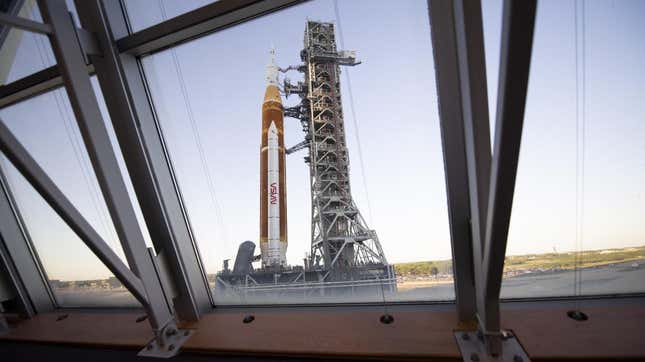
NASA will attempt another countdown rehearsal of the Space Launch System in early June, but the space agency warned that multiple tests of its finicky rocket might be necessary.
SLS returned to the Vehicle Assembly Building at Kennedy Space Center, Florida, on April 26, allowing technicians to swap out a faulty upper stage helium check valve and fix a small hydrogen leak on the tail service mast umbilical. These and other “nuisance” problems, as NASA describes them, prevented groundcrews from performing a fourth wet dress rehearsal, in which the rocket was to be fully loaded with super-cooled propellants and a full countdown practiced. NASA was hoping to perform the fourth test while the 322-foot-tall (98-meter) rocket was still standing on Launch Complex 39B, but it was not to be.
Speaking to reporters yesterday, NASA officials said they’ll try again to perform a full wet dress rehearsal in early or mid June. The added time will allow the team to resolve some lingering technical problems, perform additional checkouts of the rocket, and allow an off-site supplier of gaseous nitrogen to perform necessary upgrades of its pipeline system.
SLS is a key component of NASA’s upcoming Artemis program, which seeks to return U.S. astronauts to the dusty lunar surface for the first time in over 50 years. NASA also needs the megarocket to build its upcoming Lunar Gateway (a small space station in orbit around the Moon) and to enable future crewed trips to Mars. The SLS program has suffered from cost overruns and delays, with these latest setbacks adding insult to injury.
Assuming a successful rehearsal can be completed in June, the rocket will once again roll back to the Vehicle Assembly Building for final launch preparations and “some work that we’ve deferred to the other side of the wet dress,” as Jim Free, associate administrator for exploration systems development at NASA, explained during the media teleconference. Upcoming launch periods for the uncrewed Artemis 1 mission include July 26 to August 9 (Free said NASA is not considering the July portion of this period), August 23 to 29, and September 2 to 6. Somewhat ominously, Free said launch windows have been laid out for the rest of the calendar year but didn’t provide specific dates. NASA will wait for the results of the next wet dress to make a decision about when to launch.
Free, explaining that he wanted to be “realistic” and “upfront,” said “it may take more than one attempt” to conclude a wet dress and to “get the procedures where we need them for a smoother launch count that gives us the best chance to make our launch windows when we get to the launch day.” As this is the first time we’re hearing that multiple attempts might be necessary, and given the slew of problems encountered during the first three tests, I asked Free if the rocket is proving to be more complicated than NASA thought.
“SLS isn’t proving to be more complicated—we knew it was complicated,” he responded. A particular challenge, Free said, has been operating the new ground systems for the first time and seeing how they react. The team is “not going to take it for granted” that the next wet dress is “going to be great” based on what was experienced during the first three attempts, he said. A certain amount of realism is needed in the approach and the “team needs our support,” he added. This includes managing the team’s workload, who have “been going at it for quite a while now,” Free said. “This is really hard work.”
SLS should depart the Vehicle Assembly Building in late May, with the wet dress expected in early or late June. This is no guarantee, as technicians haven’t yet determined the source of rubber debris that prevented an upper stage check valve from operating during an earlier test. The umbilical hydrogen leak on the pad also needs to be repaired to the team’s satisfaction (the problem is being remedied with the periodic re-torquing of bolts), while the vendor of the gaseous nitrogen, Air Liquide, needs to demonstrate that it can deliver the gas to SLS as required, as Cliff Lanham, senior vehicle operations manager at NASA, told reporters.
On a positive note, NASA will have live commentary for the next SLS rehearsal, which hadn’t been done for the first three tests, apparently for security reasons.